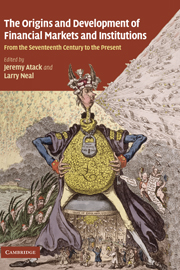 The Origins and Development of Financial Markets and Institutions
The Origins and Development of Financial Markets and Institutions Published online by Cambridge University Press: 04 August 2010
Just before the sub-prime crisis broke in August 2007, an op-ed piece by David Hale in the Wall Street Journal boldly asserted that never in the history of the world has the human race enjoyed such material prosperity. The facts back him up. With a record population of 6.6 billion and an average per capita income of $10,200 in 2006, the world's gross domestic product was still growing at over 5 percent annually in real terms and thus at 2–4 percent per capita. Never has there been so many people living and never has their per capita income been so high. Moreover, never before have there been such bright prospects for the future. Driving this phenomenal achievement, most economists agree, is the rise of trade, starting with the industrialized West after World War II, including the oil producing countries in the 1970s, and finally encompassing the centrally-planned economies of China, India, and the former Soviet Union in the 1990s. Despite occasional tremors in the stock markets of the world, the global economy is awash in liquidity as a result of the unprecedented breadth and depth of prosperity, which has generated high profits in all the countries participating in increased trade.
The resulting savings, Hale argued, as have others, are directed by the increasingly efficient financial markets of the world toward their most efficient investment opportunities. Global finance, in short, provides the basis for continued prosperity.
To save this book to your Kindle, first ensure [email protected] is added to your Approved Personal Document E-mail List under your Personal Document Settings on the Manage Your Content and Devices page of your Amazon account. Then enter the ‘name’ part of your Kindle email address below. Find out more about saving to your Kindle.
Note you can select to save to either the @free.kindle.com or @kindle.com variations. ‘@free.kindle.com’ emails are free but can only be saved to your device when it is connected to wi-fi. ‘@kindle.com’ emails can be delivered even when you are not connected to wi-fi, but note that service fees apply.
Find out more about the Kindle Personal Document Service.
To save content items to your account, please confirm that you agree to abide by our usage policies. If this is the first time you use this feature, you will be asked to authorise Cambridge Core to connect with your account. Find out more about saving content to Dropbox.
To save content items to your account, please confirm that you agree to abide by our usage policies. If this is the first time you use this feature, you will be asked to authorise Cambridge Core to connect with your account. Find out more about saving content to Google Drive.